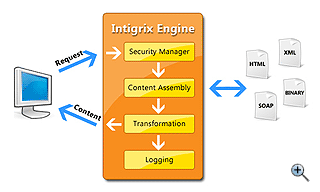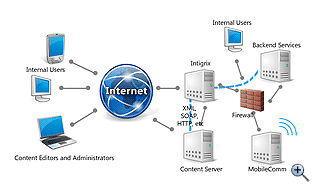What is an Integration Broker?
An Integration Broker refers to a new type of software that handles the envokation of remote services, assembly and finally transformation of the results from these services. Think of the Integration Broker as a "middle-man" between users and backend services. The difference between an Integration Broker and the "middle-ware" of the past is that an Integration Broker does not use proprietary technologies but instead relies on a standard set of protocols to communicate with the users as well as the back-end services making Integration brokers the perfect bridge between today's Internet users and business systems.
How does Intigrix™ work?
Aside from being an Integration Broker, the Intigrix™ platform also includes a strong security model effectively blocking access to or provide any information of the site owner's backend services. All requests goes through the security manager which checks whether the content requested can be provided to the user. If yes, the content can either be retrieved from the internally stored (and maintained) pages of Intigrix™ or retrieved from a remote web service or database. Retrieved data can take many forms, either plain HTML, in XML or SOAP or even binary in nature. Upon complete retrieval, the content is transformed to the appropriate format for the user's device (HTML for computer's, WAP for mobile devices) and sent back to the user.
Stand-alone Use
Intigrix™ can be used as a stand-alone server in which case it primarily functions as a corporate web server or intranet server. With its content management features Intigrix™ provides a complete set of functionality to make any web project easy to maintain and achieve its purpose.
As Integration Platform
The full capabilities of Intigrix™ is realized once it is used as an integration platform. When used as such, organizations typically have secured back end systems that is being accessed through Intigrix. This effectively insulates corporate systems from the Internet. Backend systems are accessed through direct HTTP or Web service calls.


